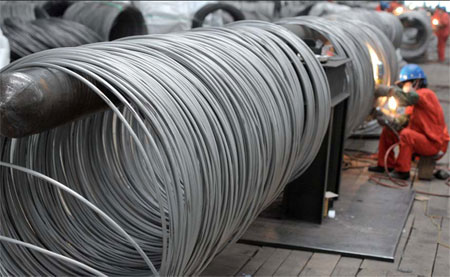Steelmakers bend as realty wanes
Updated: 2012-10-19 10:37
By Zhao Yanrong (China Daily)
|
|||||||||||
|
A worker checks the quality of steel products at a factory in Dalian, Liaoning province. Liu Debin / for China Daily |
Companies need to move up the value chain, and reduce their reliance on property to stay afloat
Though the property industry in China has somewhat managed to weather the economic turbulence, the winds have not been kind to allied industries like iron and steel.
Property continues to be the mainstay of the GDP, but its lackluster performance has left the iron and steel industry somewhat like the hungry sailors cast adrift in choppy seas. Existing orders are shrinking rapidly, while there are no new orders in sight, industry sources say.
Though the fortunes of 20 industrial clusters and more than 50 upstream and downstream industries are directly associated with the property sector, it is the iron and steel sector that faces the maximum impact.
Housing construction has slowed in China in the last few months due to the weak external economic sentiment, and also due to several policy curbs that have crimped fresh buying.
According to the China Iron and Steel Association, crude steel output rose by 1.8 percent during the first six months of this year to 357 million tons, while the total profit in the same period was 2.39 billion yuan ($380 million; 295 million euros). Though inventories rose during the first six months, the sale profit rate was just 0.13 percent. More than 33 percent of the companies in the sector have run up huge losses, with the industry loss for the period estimated at some 12.25 billion yuan.
"The loss during the first three months was nearly 32 times the loss in 2011," says Qu Xiuli, deputy secretary-general of CISA.
More than 55 percent of the iron and steel made in China is used in various sectors, while 20 percent is directly used in real estate programs, says Zeng Jiesheng, manager and senior researcher at Mysteel Research Institute.
Fixtures and rebars account for most of the iron and steel usage in property construction. During the first eight months of this year, the new housing construction area was only 1.23 billion square meters, a 6.8 percent decline from the same period in 2011.
"Iron and steel are highly related investments and their success depends largely on the fortunes of the property market," says Li Xinchuang, president of the China Metallurgical Industry Planning and Research Institute.
But with most of the industry experts not overtly optimistic on a quick property market rebound, there seems to be more dismal days ahead for steelmakers.
Even though housing transactions have improved somewhat and some developers have announced new projects in the last two months, there seems to be no immediate sign of easing the market controls in the near future, says Zeng of Mysteel Research Institute.
"The rebound of the property market is limited, and the demand for iron and steel continues to be on the downside. I do not see any immediate opportunities for the raw material market to turn profitable from a realty rebound," he says.
But like every dark cloud has a silver lining, the dismal returns have propelled many steelmakers to test the real estate waters to shore up revenues. According to National Business Daily, most of the top 10 Chinese steelmakers have ventured into real estate development.
The iron and steel industry had a relatively low sale profit rate of about 2.4 percent last year, and 2.9 percent in 2010. The most profitable year for the industry was 2005, when the number reached 6 percent. Compared with the huge payback in the real estate market, the raw material industry has witnessed only slower returns.
Though most of the steelmakers have defended their recent property moves as housing programs for employees, analysts say such diversification strategies may not be enough to pull them out of the woods.
"To tide over the difficult economic situation, iron and steel companies should try to upgrade their production process to further lower costs and improve quality," says Li from Metallurgical Industry Planning and Research Institute.
According to Li, the iron and steel industry in China is still fragmented despite the more than 30 years of existence. The unorganized nature of the iron ore trade has made it difficult for the industry to look for ways to lower production costs, say experts.
"The property market's performance has a huge influence on the iron and steel industry. But when the realty industry is transferring to the next level, the iron and steel industry should also try to improve its own system and create a healthy growth mode which is less reliant on realty demand," Li says.
zhaoyanrong@chinadaily.com.cn
(China Daily 10/19/2012 page5)
Today's Top News
Rescuers race against time for quake victims
Telecom workers restore links
Coal mine blast kills 18 in Jilin
Intl scholarship puts China on the map
More bird flu patients discharged
Gold loses sheen, but still a safe bet
US 'turns blind eye to human rights'
Telecom workers restore links
Hot Topics
Lunar probe , China growth forecasts, Emission rules get tougher, China seen through 'colored lens', International board,
Editor's Picks

|

|

|

|

|

|






